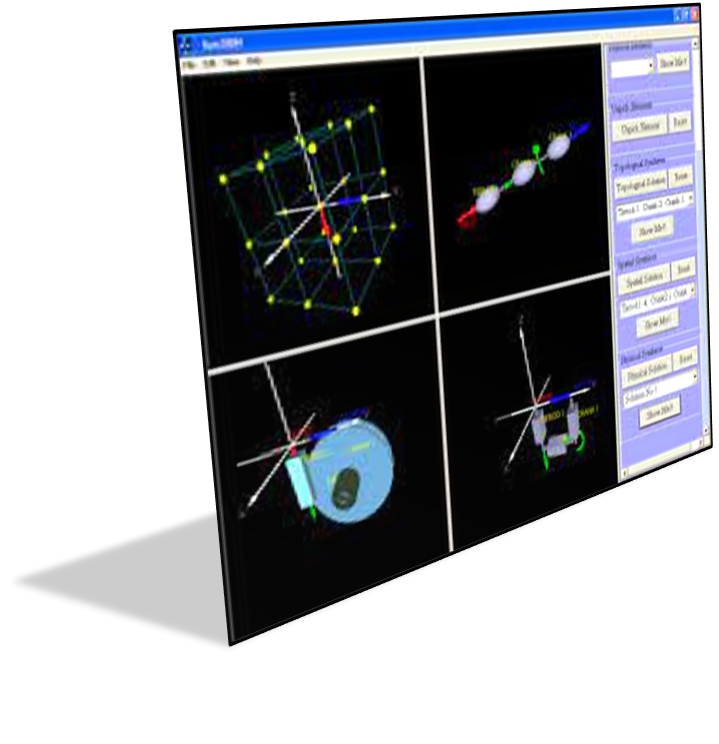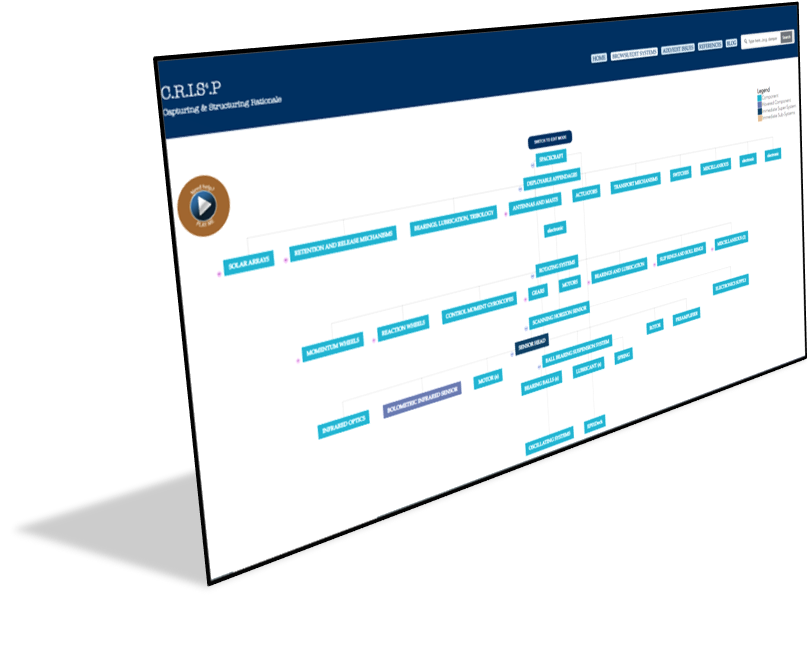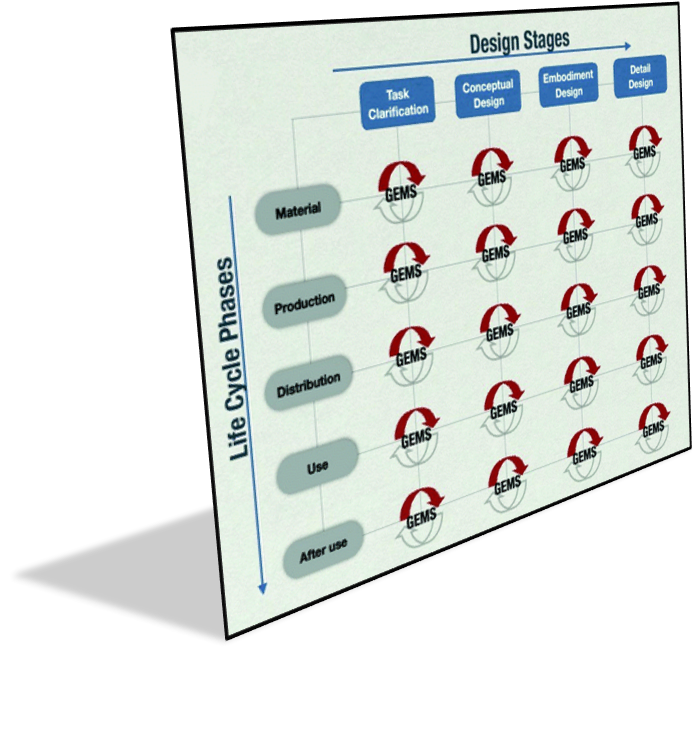IDEA-INSPIRE is a computational tool for supporting designers to generate novel solutions for product design problems by providing, as stimuli, information about natural or artificial systems that are analogically relevant for solving the problem. It uses the corpus of the diverse motions that nature exhibits as a potent source of inspiration for solving product design problems, especially in inspiring creativity and innovation of novel products. The software has a database with entries from natural and artificial systems, annotated in a unique behavioral language, so that automated analogical search can be carried out to retrieve entries that have strong likelihood of inspiring novel solutions to a given design problem. The designer can browse through the database or incase he has a specific design problem to be solved, he can as well use the various search strategies to find suitable entries.
Research Areas
Requirements Engineering and Design for Variety
According to a study, over 40% of all defects in a product are due to either requirements not appropriately identified or utilized during design. Identification of appropriate requirements early in the product development process and their appropriate utilization during the process are essential for developing high quality products. The focus of work has been to understand the process and mechanisms of requirement identification and satisfaction, and their impact on the quality of products and process.
Design for variety refers to commonalising various aspects of a product portfolio in order to optimize costs of a product while offering equivalent variety to the customer segments. The focus of research has been to provide commonalisation of materials and processes across a product portfolio.
Design Synthesis and Creativity
Engineering design synthesis is considered as a fundamental subset of the process of engineering design that helps in the transformation of function into alternative, creative structures that can satisfy the function. Many researchers consider engineering design synthesis as a central area of design research. Earlier work in this area can be categorised under one or more of the following questions:
What is engineering design synthesis?Several researchers have defined engineering design synthesis. The definitions are often overlapping and comprise: synthesis as designing, synthesis as problem solving, synthesis as design solution generation, synthesis as design problem and solution generation and synthesis as exploration, which together comprise the processes of task formulation, design representation, composition, design generation, design interpretation and re-interpretation, design evaluation, search and optimization.
How is engineering design synthesis currently done carried out?This involves understanding several theories, models and approaches proposed earlier for engineering design synthesis. This understanding serves as the basis for the improvement of engineering design synthesis.
How to support design synthesis?Based on an understanding of how engineering design synthesis is performed, guidelines, methods, tools, etc. are developed and evaluated to better support engineering design synthesis.
Design Creativity is the ability to identify, visualize and interpret a problem in unusual and interesting ways and to synthesise and develop novel and interesting ideas and solutions. Our research led to the development of: (1) a common definition of creativity that provided an overarching view of what were reflected variously in the myriad definitions by earlier authors, (2) a set of empirically validated measures for the two crucial components of technical creativity , novelty and usefulness , and their relationships to creativity, and (3) the major factors that influence design creativity. A major observational study undertaken discovered that only four fundamental search processes occurred in engineering design, irrespective of what design problems are solved, by whom, and whether individually or in teams.
Eco-Design and Sustainability
Eco-Design is an approach to designing systems with an intent of reducing its impact on the environment. It is often used synonymously with green design, design for environment. One of the guiding principles of Eco-Design is to consider environmental impacts in the entire lifecycle: from raw material extraction to after-usage through production, distribution and usage. Our research involves understanding designers requirements and developing frameworks, methods and tools to assist them in designing systems with environmentally friendly lifecycles.
Sustainability is the ability to meet our needs and aspirations without compromising the ability of future generations to meet their own needs and aspirations. The term sustainability is generally referred in the context of development i.e. in Sustainable Development. To develop sustainably is to continue improvement in harmony with the environment, society and economy.
Design Collaboration and Knowledge Management
Knowledge Management is about people, using technology to enable more efficient processes so that they are better able to capture, store, retrieve, use, reuse and share both explicit and tacit knowledge for the financial and business interest of the company (Hylton, 2002). When it concerns product development, knowledge management addresses the needs of product development teams to capture, store, and effectively utilize knowledge in the organization. The research questions of interest include: what types of knowledge are generated in an organization? How much of these are captured and reused? What knowledge is not captured that should have been otherwise?
The current design scenario of ever increasing customer requirements and continuous reduction in products life, forces companies to develop more complex and innovative products with high quality and low cost concurrently, in order to meet the above challenges with an ever decreasing time to market. Collaborative design is an area that has high potential impact in enabling companies achieve this. Companies should utilize all competence available, work in teams and scout for talent across the globe to face these challenges. Collaborative design is a process in which products are designed through collective effort of many designers. Distributed collaborative design is a process in which products are designed through collaboration among design teams that often work in parallel, using various engineering tools distributed in separate locations, across various time zones around the world. A large number of factors influence the collaborative design. Currently the relationships among these factors are not well-understood. The current research interests include: understanding and structuring interactions among designers during co-located and distributed design collaborations, and the knowledge processes that occur during these interactions.
Product Aesthetics and Design for Emotions
Better looking products attract more customer attention. As technology in products saturates, the appeal of the product to the customer becomes the key differentiator; this is known to strongly influence purchase decisions. Also, in an increasingly competitive market wherein producers vie for limited consumer attention, the look and feel of products virtually drive the bottom-line of some sectors. Given that purchase decisions cumulatively make or break companies, research in this area assumes great importance. We are interested in questions such as: What constitutes aesthetic appeal of a product? How to make products aesthetically appealing?
Emotions enliven us every day and hour. Products we interact with seem to gather more importance as they enhance our capabilities. In such a context it becomes important to know in what way products are used as intended by designers. Across varied sectors of product manufacturers this requirement is varied, though fundamentally it is the emotion that the products evoke in us that strike connections engaging us in intended or un-intended way. How to make products convey or evoke particular emotions? Answers to such questions are necessary for designers of all kinds of products. This is our primary research interest.
Design Pedagogy
Design pedagogy is the area of inquiry into processes and tools for design learning and education. Work carried out in IdeasLab in this area include development of new teaching methods and curricula in the areas of design methodology, design creativity, and design research methodology.
Design Research Methodology
A research discipline is as good as its research methodology. The relatively new and interdisciplinary discipline of design research requires a robust, well-tested research methodology for supporting the quality of research output and its acceptance in the industry and society. Design Research Methodology: I developed DRM (jointly with Ken Wallace in Cambridge and Lucienne Blessing in Luxembourg) - arguably the most widely used design research methodology in the world. DRM has been taught in several national and international courses for the last ten years in Europe and India, training over four hundred PhD students in using DRM for their research. DRM has also been published in a Springer book in July 2009, co-authored by the Lucienne Blessing and myself, and already sold over three hundred copies. Current research constitutes further development of detailed aspects of the methodology in collaboration with Lucienne Blessing.
Products
The Functional Synthesis model is based on a novel representation of a set of generic mechanical device building blocks that can be combined to automatically generate an exhaustive set of technical solutions to a given mechanical function, at the topological, spatial as well as physical levels of abstraction. The model has been integrated into FuncSION (Functional Synthesizer of Input Ouput Networks) - computer-based software for functional synthesis that generates a comprehensive variety of mechanical design concepts as stimuli for ideation by designers.
IDEA-SUSTAIN is a computer aid based on a patented impact estimation and rational capture technology to help designers develop environmentally friendly product lifecycles by supporting synthesis in product development on a commercial CAD workspace, while also aiding automated capture of the rationale behind the decisions for retrieval during design, and supporting environmental impact analysis of product proposals created by automatically extracting information already stored while designing and asking for other information required to model the lifecycle, with minimal extra effort from the designer. It uses a novel method for uncertainty reasoning to estimate the level of confidence on the impact value owing to the incompleteness in information available. The estimation is possible at component, assembly or product levels, for a single lifecycle phase or for multiple phases. It also helps in comparing different lifecycle proposals under uncertainty. Empirical studies demonstrated significant reduction in impacts on the environment for product life cycles designed using IDEA-SUSTAIN compared to those designed using existing commercial tools.
C.R.I.S4.P - Capturing Rationale as Issues and Solutions using Systemic, Sequential, SAPPhIRE rePresentation The tool aims to capture and organize rationale using the 3 dimensional representation (S3) and manage issues based on causal descriptions. The dynamic database incorporates an ontological approach to issues experienced in space design recorded in the past by various space organizations like NASA, ISRO etc.
InDeaTe—Innovation Design Database and Template—is a knowledge-driven, sustainable design process support tool, aimed at improving sustainability considerations in design. It comprises a design process template that guides ‘life cycle thinking’ into design by creating intersections of stages of design with life cycle phases at which design activities are directed. The tool also has a design database of sustainability definitions and indicators, and methods and tools, for solving a given design problem by supporting the template. InDeaTe can support design of sustainable products, services and manufacturing systems by retaining its inherent characteristic of exploration and innovation, while offering a multitude of possibilities and routes towards achieving the design goal.



